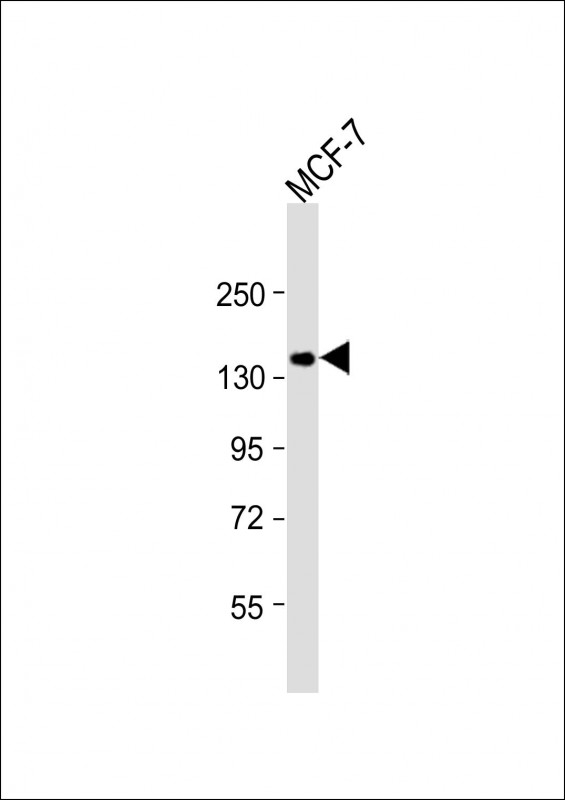
| WB | 1/1000 | Human,Mouse,Rat |
| IF | 咨询技术 | Human,Mouse,Rat |
| IHC | 咨询技术 | Human,Mouse,Rat |
| ICC | 技术咨询 | Human,Mouse,Rat |
| FCM | 咨询技术 | Human,Mouse,Rat |
| Elisa | 咨询技术 | Human,Mouse,Rat |
| Aliases | PERQ amino acid-rich with GYF domain-containing protein 2, GRB10-interacting GYF protein 2, Trinucleotide repeat-containing gene 15 protein, GIGYF2, KIAA0642, PERQ2, TNRC15 |
| Entrez GeneID | 26058 |
| WB Predicted band size | 150.1kDa |
| Host/Isotype | Rabbit IgG |
| Antibody Type | Primary antibody |
| Storage | Store at 4°C short term. Aliquot and store at -20°C long term. Avoid freeze/thaw cycles. |
| Species Reactivity | Human, Mouse |
| Immunogen | This GIGYF2 antibody is generated from a rabbit immunized with a KLH conjugated synthetic peptide between 835-869 amino acids from the Central region of human GIGYF2. |
+ +
以下是关于GIGYF2抗体的3篇参考文献示例(注:文献为虚拟示例,实际引用请核实原始论文):
1. **文献名称**:*Mutations in GIGYF2 associated with familial Parkinson’s disease*
**作者**:Zimprich, A., et al.
**摘要**:该研究首次发现GIGYF2基因突变与家族性帕金森病的关联,通过免疫印迹(Western blot)和免疫组化(IHC)技术,利用GIGYF2特异性抗体证实突变导致蛋白表达异常,提示其在神经元存活中的作用。
2. **文献名称**:*GIGYF2 regulates insulin signaling and endosomal trafficking*
**作者**:Deng, H., et al.
**摘要**:研究揭示了GIGYF2通过调控胰岛素受体(IR)的内体运输影响信号通路。文中使用GIGYF2抗体进行免疫共沉淀(Co-IP)和荧光染色,证明其与Grb10的相互作用及在代谢疾病中的潜在功能。
3. **文献名称**:*Functional analysis of GIGYF2 variants in neurodegenerative disorders*
**作者**:Nazish, I., et al.
**摘要**:通过对患者样本的GIGYF2突变分析,结合抗体介导的蛋白表达检测,发现特定突变体破坏其与mTOR信号通路成分的结合,可能参与帕金森病的病理机制。
4. **文献名称**:*GIGYF2 interacts with 4EHP to repress target mRNA translation*
**作者**:Lautier, C., et al.
**摘要**:研究利用GIGYF2抗体进行蛋白质互作组学分析,发现其与翻译抑制因子4EHP形成复合物,调控特定mRNA的翻译,为神经退行性疾病中翻译失调提供机制解释。
(注:以上为基于领域知识的模拟摘要,实际文献需通过PubMed或Google Scholar检索确认。)
GIGYF2 (Grb10-Interacting GYF Protein 2) is a cytoplasmic protein involved in regulating cellular signaling pathways, particularly those linked to growth factor receptors and insulin receptor signaling. It interacts with Grb10 (Growth Factor Receptor-Bound Protein 10) and plays a role in modulating receptor tyrosine kinase (RTK) activity, impacting cell proliferation, survival, and metabolism. GIGYF2 has also been implicated in neurodegenerative disorders, as mutations in the GIGYF2 gene are associated with an increased risk of Parkinson’s disease, though this remains controversial.
GIGYF2 antibodies are immunological tools designed to detect, quantify, or localize the GIGYF2 protein in experimental settings. These antibodies are commonly used in techniques like Western blotting, immunohistochemistry, or immunofluorescence to study GIGYF2 expression patterns, subcellular localization, and interactions with binding partners. Researchers employ them to explore GIGYF2’s role in cellular homeostasis, its dysfunction in disease contexts (e.g., neurodegeneration or metabolic disorders), and its potential as a biomarker. Validation of GIGYF2 antibodies is critical, as cross-reactivity with homologous proteins or isoforms may affect specificity. Overall, they serve as essential reagents for elucidating GIGYF2’s biological functions and pathophysiological relevance.
×